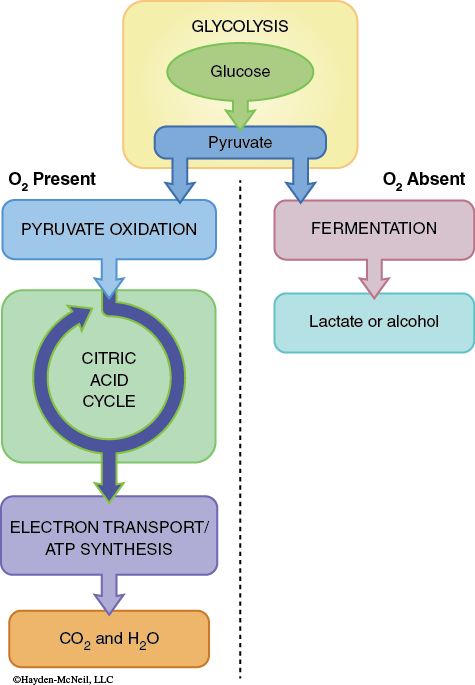Chapter 2. Carbon Metabolism: Fermentation
General Purpose
This pre-lab will present some of the general concepts related to the process of fermentation.
Learning Objectives
General Purpose
- Develop a basic understanding of the reactions of fermentation.
This is the third in a series of laboratories that will explore some of the concepts involved in general metabolism of carbon compounds by organisms. The understanding of how cells and organisms create or use these carbon-based molecules is an important part of comprehending how energy is used in biological systems.
Background Information
The process of fermentation provides a mechanism by which some cells can metabolize organic nutrients and produce ATP in the absence of oxygen. Glycolysis converts glucose to two pyruvates and generates two ATP molecules and two molecules of the reduced form of nicotinamide adenine dinucleotide (NADH) (Figure 9-1).

The NADH created by this process is often reconverted back to the oxidized form of nicotinamide adenine dinucleotide (NAD+) by subsequent reactions that occur during the electron transport phase of cellular respiration (Figure 9-2). These subsequent steps require aerobic conditions (the presence of oxygen). When cells or organisms are under anaerobic conditions (without oxygen) the normal mechanism for regenerating NAD+ from NADH is stopped. Since NAD+ is an essential electron carrier in the glycolytic pathway, without an alternative pathway for regeneration, the depletion of the pool of NAD+ would stop glycolysis and ATP production. To overcome this problem, yeasts and other organisms can further metabolize pyruvate by the anaerobic process of fermentation (Figure 9-2).

Fermentation includes a set of reactions that regenerates NAD+ and produces waste products from the pyruvate. In many bacteria, fungi, protists, and animal cells, this process results in the formation of lactate. This anaerobic process is therefore called lactate (or lactic acid) fermentation. In yeasts and most plant cells, however, the pyruvate is converted to ethanol and carbon dioxide, and the process is called alcohol fermentation. The delightful aroma of freshly baked bread comes in part from a small amount of alcohol that is lost upon baking; the holes in bread are made by the CO2 escaping through the dough (Figure 9-3).

Pre-Lab Quiz
Proceed to the Pre-Lab Quiz